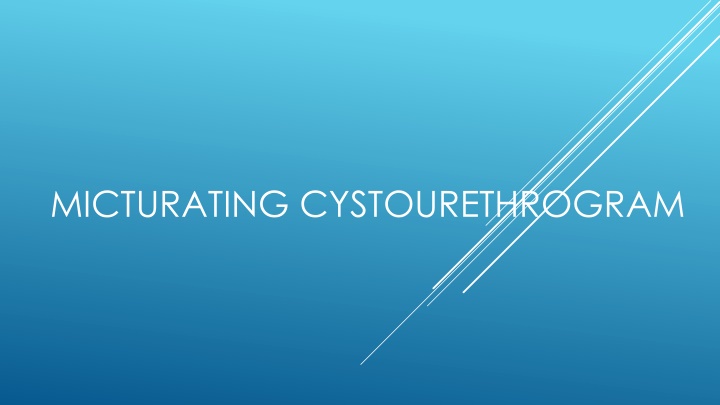MICTURATING CYSTOURETHROGRAM
Micturating cystourethrogram (MCU) is a diagnostic imaging test used to assess bladder and urethra function. It is indicated in adults for UTIs, voiding difficulties, and reflux, and in children for trauma and congenital anomalies. The procedure involves catheter insertion with contrast media to visualize the urinary tract. Complications can include infections, adverse reactions, and catheter-related issues. Filming after bladder filling helps assess for abnormalities. Adequate bladder capacity varies by age and gender, with filming techniques used to evaluate different aspects of urinary function.
Download Presentation

Please find below an Image/Link to download the presentation.
The content on the website is provided AS IS for your information and personal use only. It may not be sold, licensed, or shared on other websites without obtaining consent from the author.If you encounter any issues during the download, it is possible that the publisher has removed the file from their server.
You are allowed to download the files provided on this website for personal or commercial use, subject to the condition that they are used lawfully. All files are the property of their respective owners.
The content on the website is provided AS IS for your information and personal use only. It may not be sold, licensed, or shared on other websites without obtaining consent from the author.
E N D
Presentation Transcript
INDICATIONS ADULTS UTI-Usually done after some weeks after acute stage or may be done under antibiotic coverage. MCU is indicated after the 1st occurrence of UTI in boys or girls. Voiding difficulties like dysuria, thin stream, dribbling, frequency, urgency. Vesico ureteric reflux. Other congenital anomalies : Meningomyelocele, Sacral agenesis, Rectal anomalies. CHILDREN Trauma to urethra. Urethral stricture. Suspected urethral diverticula.
CONTRAST Water soluble constrast media like Conray 280, Trivideo 400 mg, Urograffin 60% are used which is diluted with normal saline in 1:3 ratio.
PROCEDURE Using sterile technique, a catheter is introduced into the bladder. A 5F feeding tube with side holes are used for children and in older children 5F or lOF polyethylene or soft rubber catheters with end holes are suitable. In girls after an initial inspection of the perineum to identity any local genital abnormalities (like cystoceles, or labial fusion etc.,) the urethral catheter is inserted. When it enters the bladder a varying amount of urine will flow through it. If there is no flow the catheter is advanced until urine is obtained. Suprapubic pressure is sometimes helpful in expressing a small amount of urine in the near empty bladder. If no urine is obtained the catheter may have been inserted into the vagina. In males, the foreskin is retracted and catheter is introduced. The catheter should be lubricated with an anesthetic jelly and inserted slowly and gently into the urethra holding the penis in a vertical position.
In the bladder of newborns, 30-50 cc can be instilled with ease. From about 3 years, girls can hold up to 200-250 cc and from 12 years even more. The capacity in boys is, 100-150 cc up to 5-6 years of age and 250 cc in older boys. Adequate capacity is reached when the child becomes uncomfortable and begins voiding around the catheter.
FILMING 1. AP with full bladder for demonstration of the presence or absence of VUR. 2. Both obliques to demonstrate bilateral vesicoureteric junctions. 3. Post-void film to check for a ureterocele.
COMPLICATIONS Danger of attendant infection due to catheterization of bladder. Adverse reactions may result from absorption of contrast medium by bladder mucosa. Due to technique: Acute urinary tract infection. Catheter trauma causing dysuria, frequency hematuria and urinary retention. Complications of bladder filling, e.g. perforation by the catheter or from over distention. Catheterization of vagina or ectopic ureteral orifice. Retention of a Foley's catheter. Autonomic dysreflexia: In paraplegic patients due to spinal cord injury at or above T6 level, forceful injection of contrast causes severe headache, sweating and hypertension with bradycardia due to forceful opening of the bladder neck.Treat by promptly relieving vesical distension or give diazoxide 3-5 mg/kg























